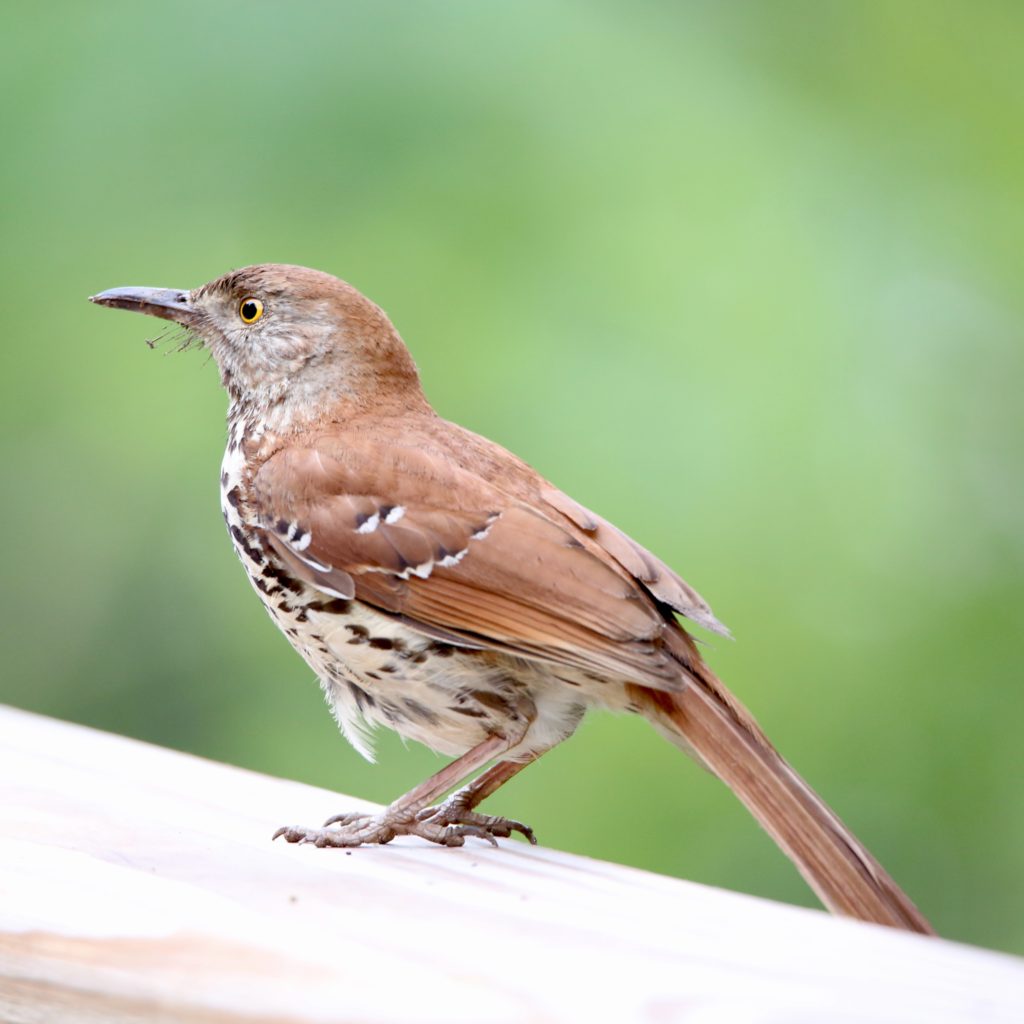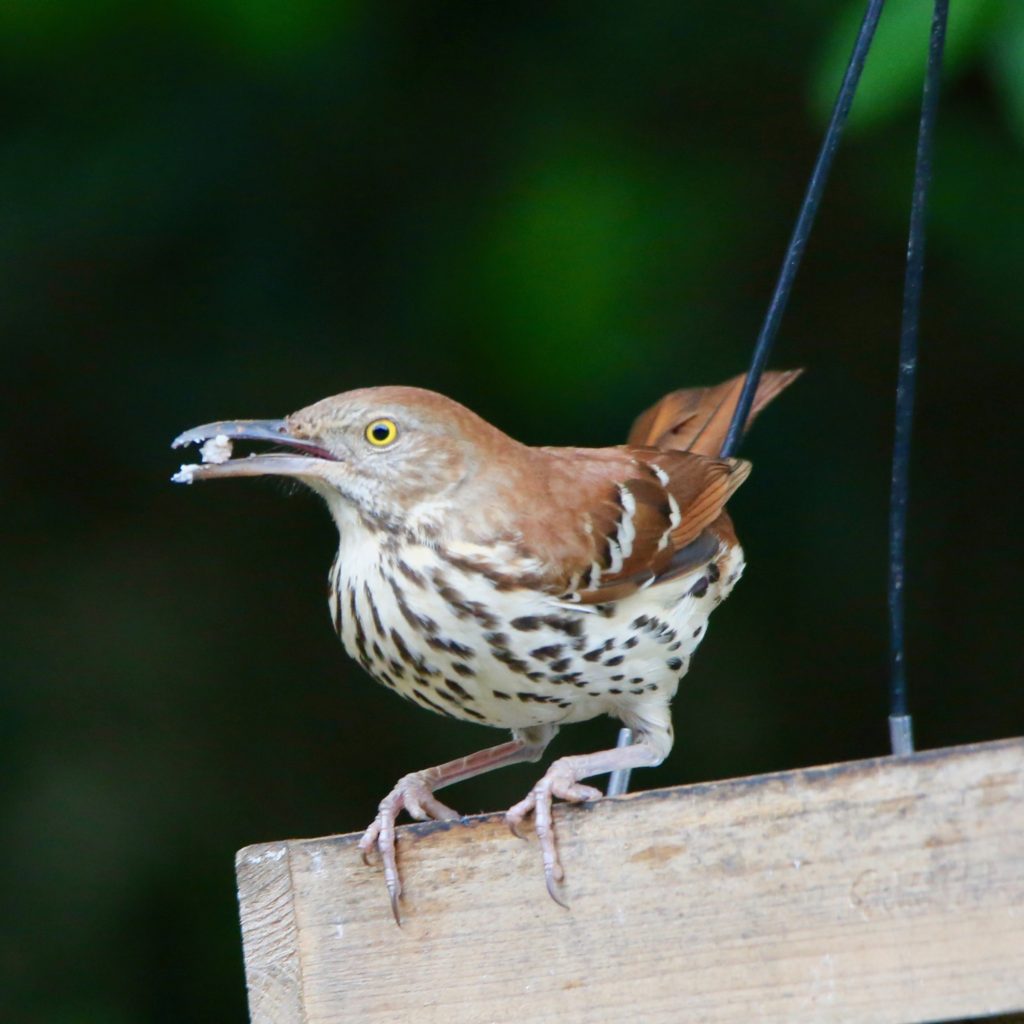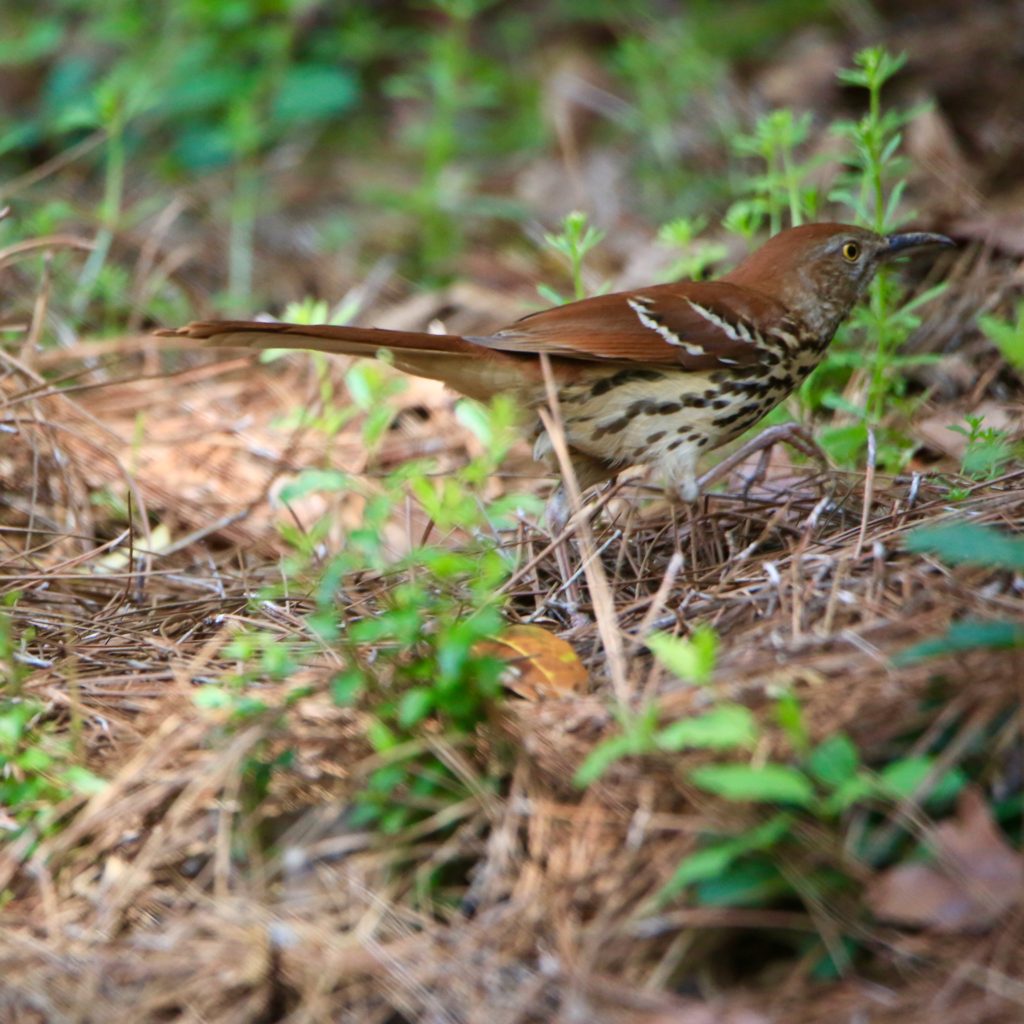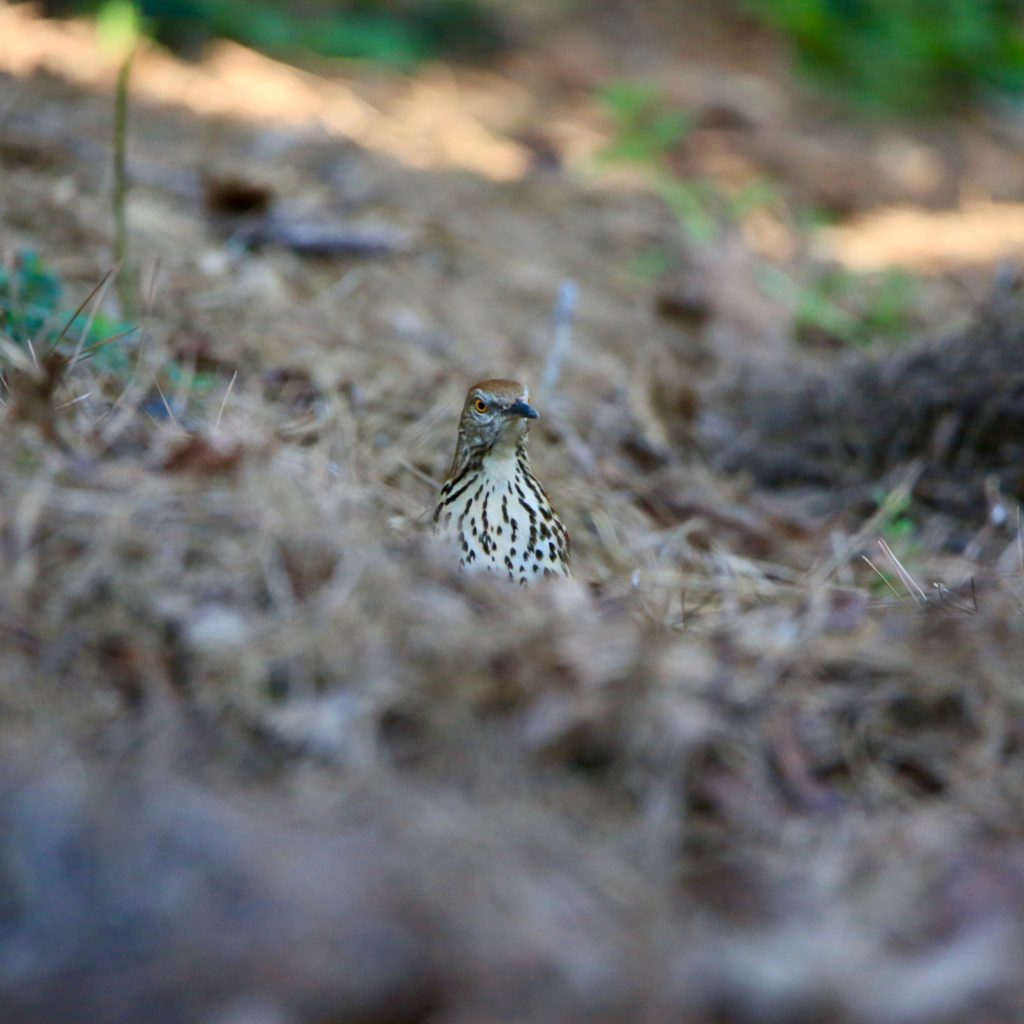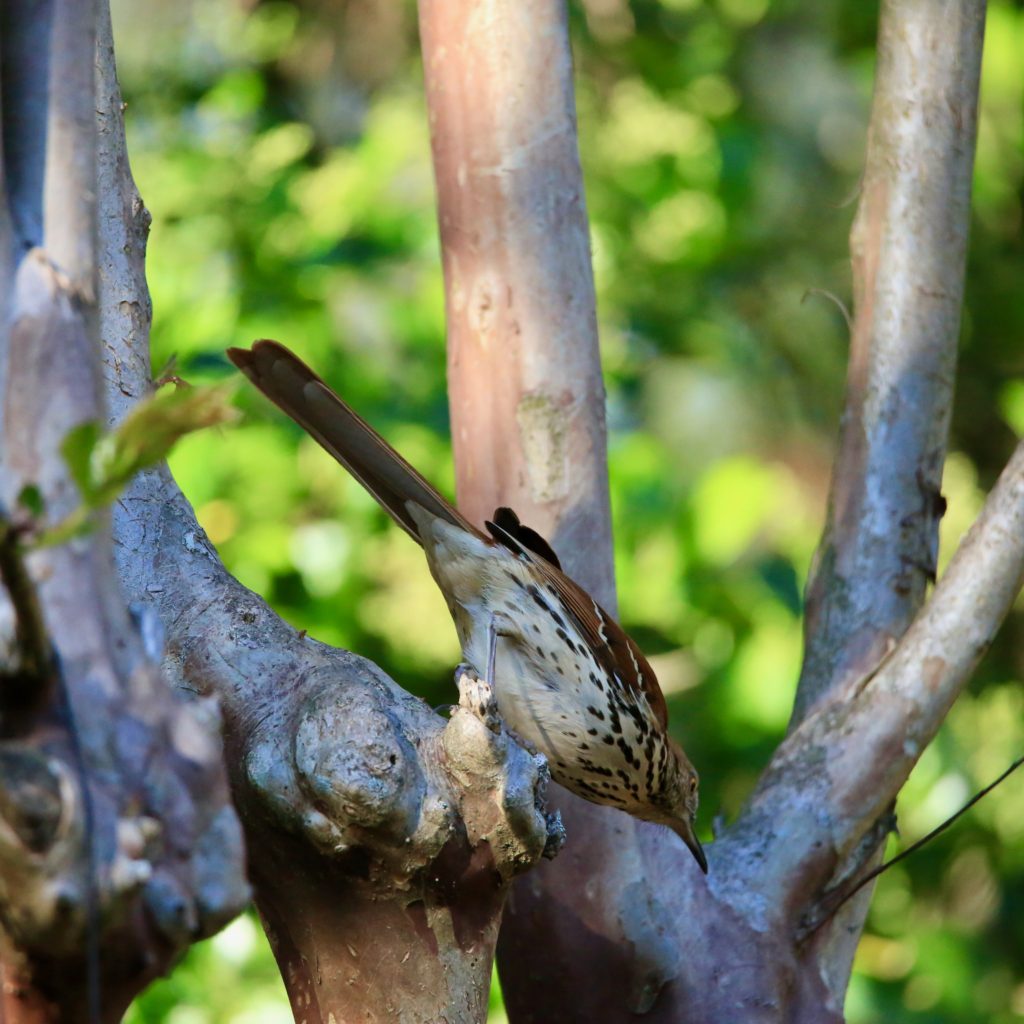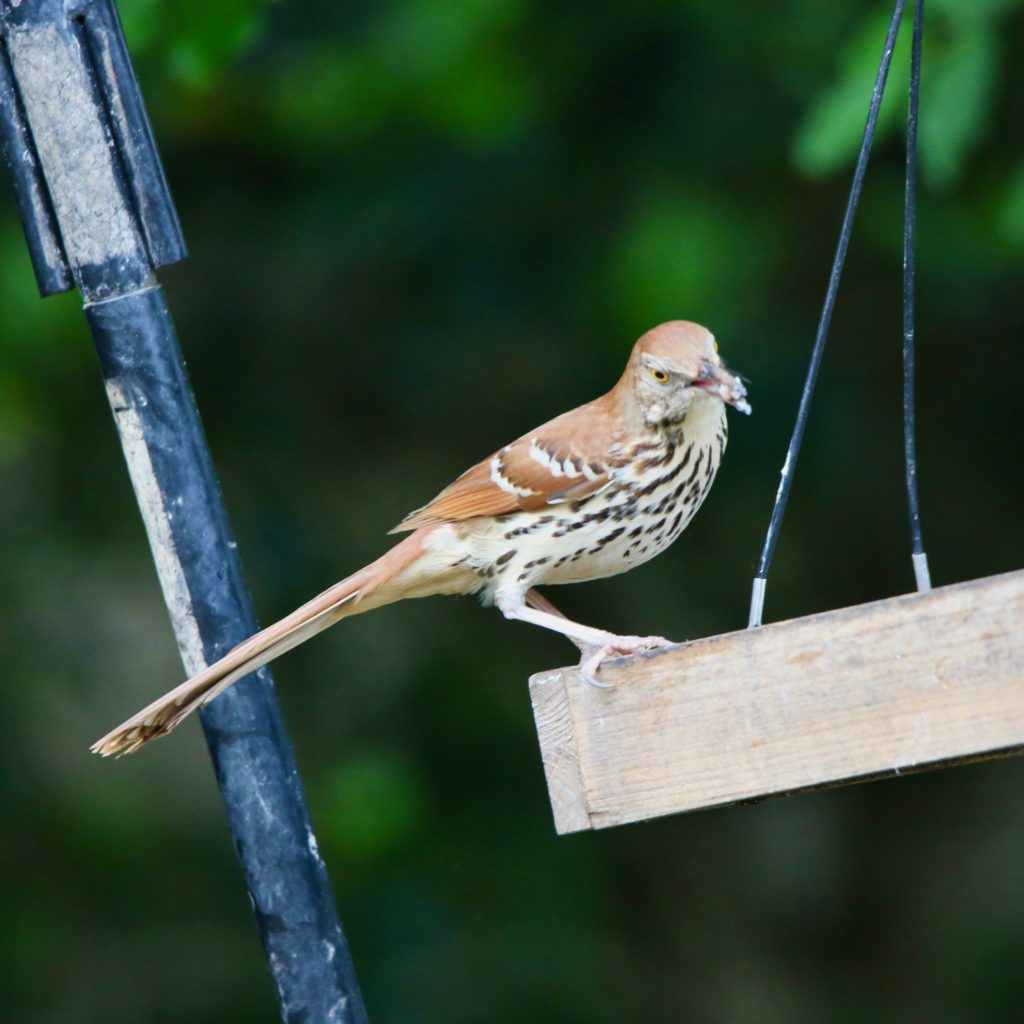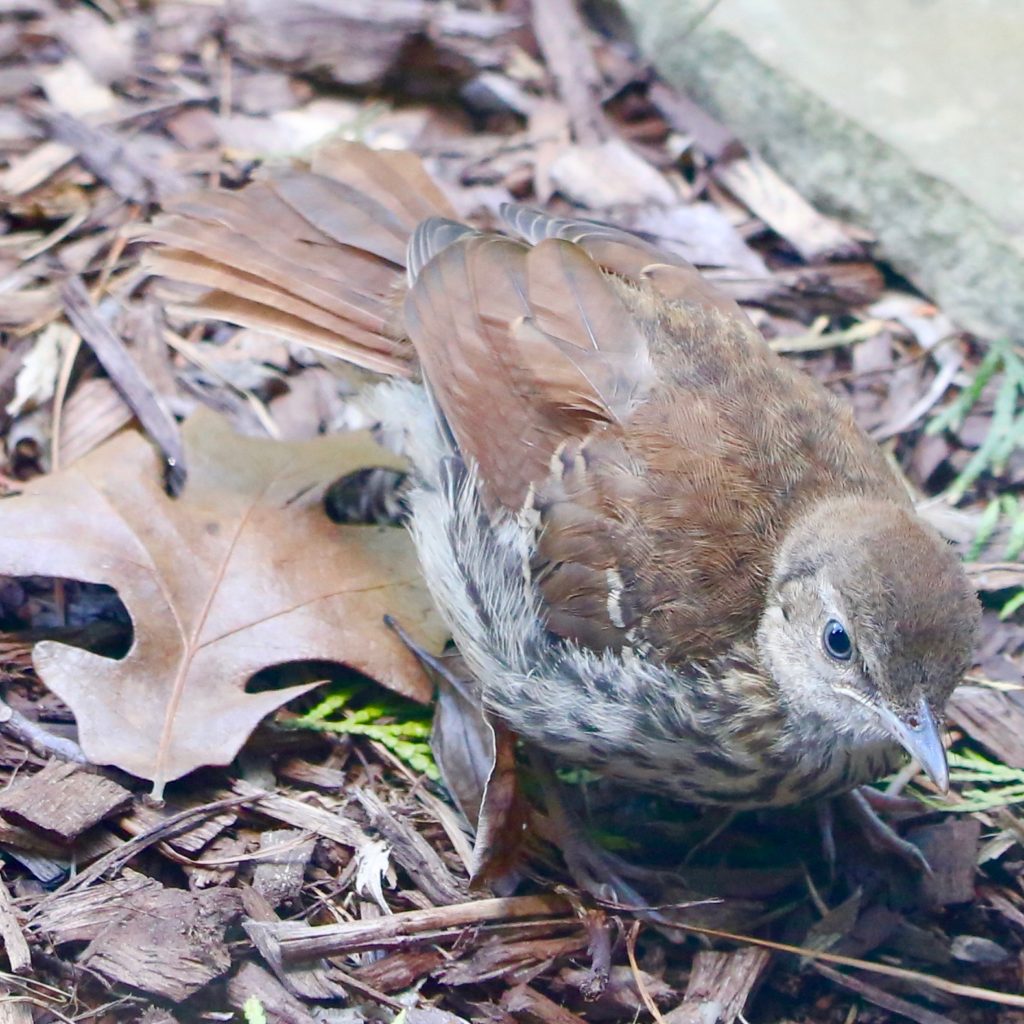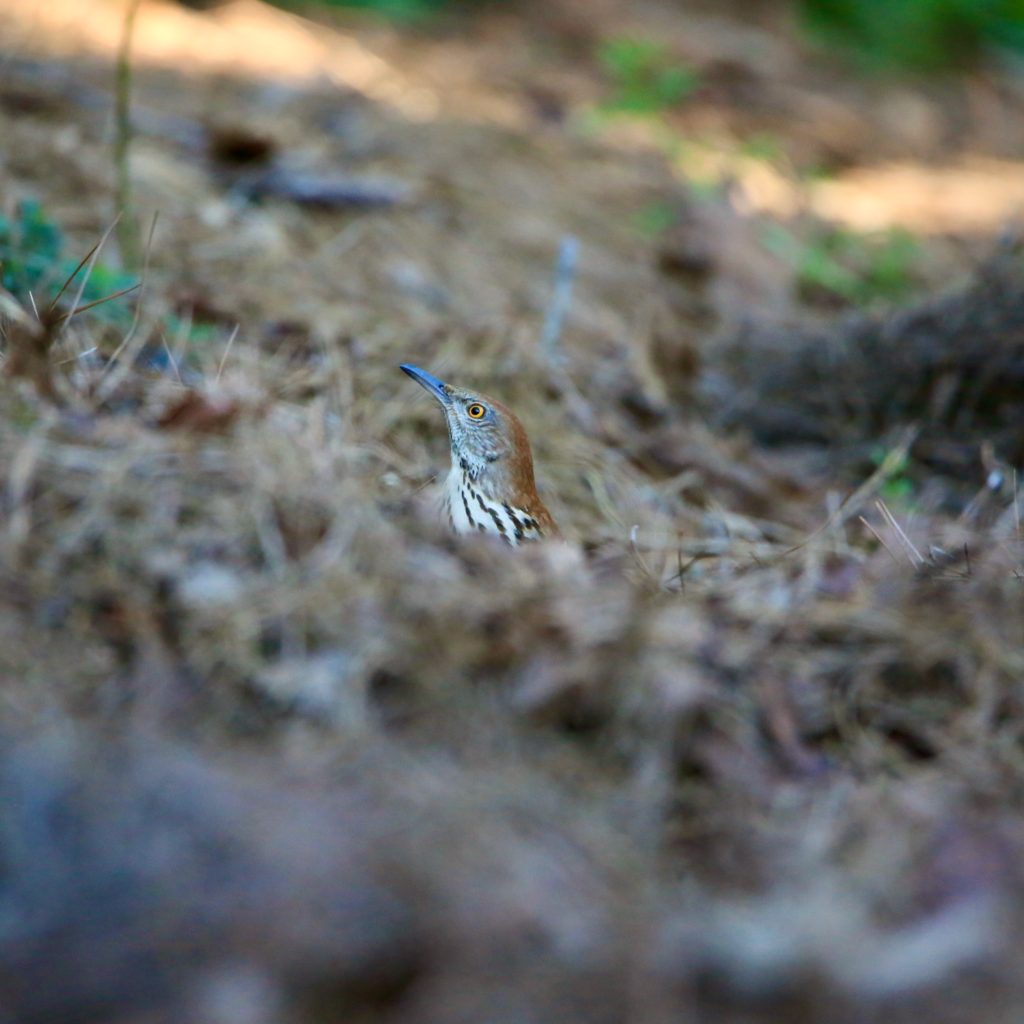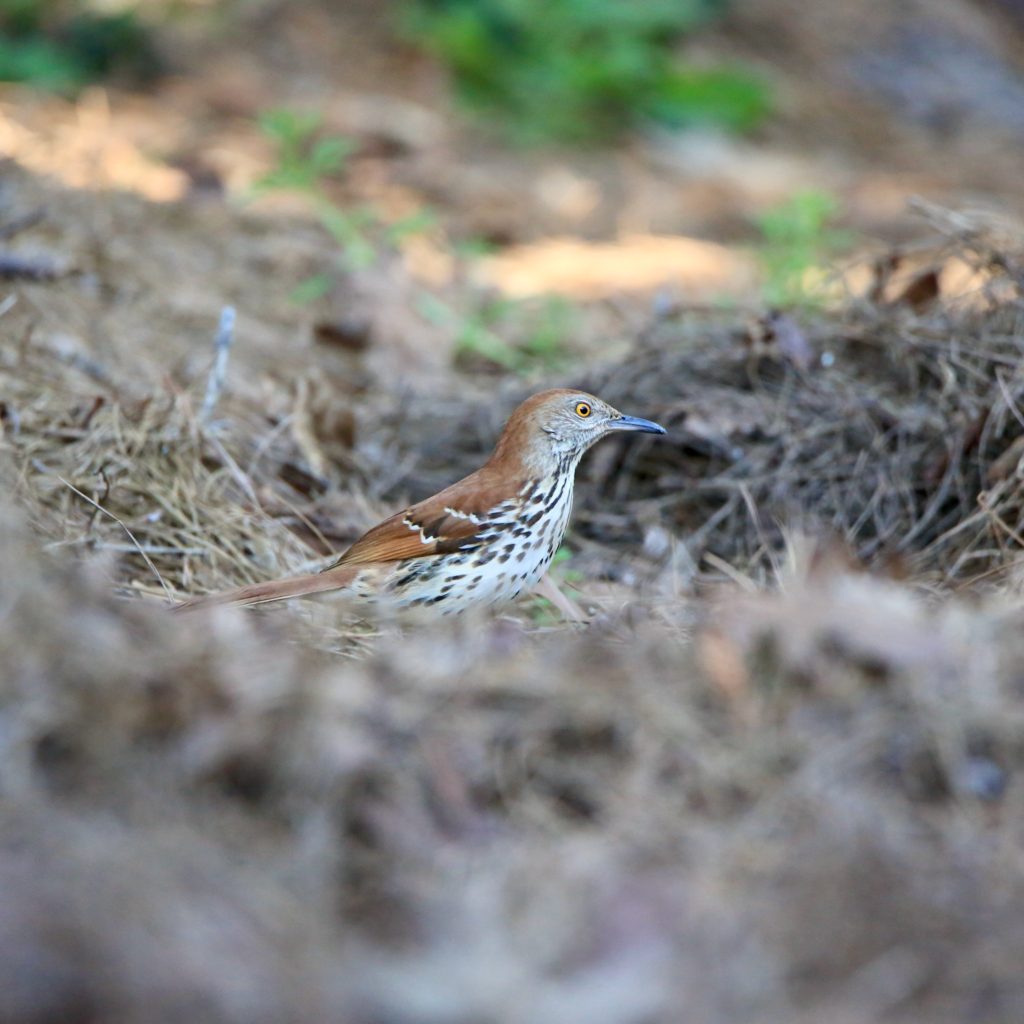
Brown Thrasher
A Brown Thrasher is a fun bird to see while bird watching. Below are some tips to help you identify Brown Thrashers. We have also put together a list of fun Brown Thrasher t-shirts, Brown Thrasher bird patches, bird houses, bird feeders, binoculars, stickers and other fun bird watching items.
About the Brown Thrasher
Brown Thrasher are exuberant singers are abundantly found in the central and eastern United States. They are also found in central and southern Canada. They are the only thrasher species found east of Texas. The Brown Thrasher is the state bird of Georgia. They can be found around forest edges and hedgerows. Some of their unique characteristics include:
Description and Identification
These are large, slender birds with foxy brown feathers. They have white and black wing bars and whitish underparts with black streaking. They have large yellow eyes and a down-curved bill. They have long sturdy legs and an extended brown tail that cocks upwards. Males, females, and juveniles do not look very different. However, juveniles do have olive eyes and a difference in the plumage texture with their indiscreet upper part markings.
Brown Thrasher Color pattern
Brown Thrashers upperparts are red-brown while their underparts are buff with black streaking. Their forehead is red-brown and their eyes are bright yellow. Their wings reveal two black and white wing bars and have brown legs.
Brown Thrasher Size
These robin-sized birds have long sturdy legs. They have a long bill that is down curved and a long tail that is cocked upwards. They are larger than the sage thrasher but dwarfed by the blue jay.
The relative size of both sexes
- Length range: 9.1-11.8 in (23-30 cm)
- Weight: 2.1-3.1 oz (61-89 g)
- Wingspan range: 11.4-12.6 in (29-32cm)
Brown Thrasher Behavior
Brown Thrashers can be found in shrubby tangles and sometimes forage on open lawns. When disturbed they hide among the shrubby tangles and make loud call notes. Although primarily found near the ground, the male Brown Thrashers sometimes deliver their melodious songs from treetops.
Brown Thrasher Diet
As omnivores, they have a diet ranging from insects to fruits and nuts. They also eat earthworms, snakes, lizards, and frogs. During summer, the breeding season, most populations of Brown Thrashers follow a diet regime primarily of grasshoppers, arthropods, beetles, etc. Studies have found that more animal matter is found in their stomachs than plant matter. Towards the end of summer, they begin shifting to a plant-based diet, eating nuts, grains, fruits, and seeds. In winter, they eat mostly fruits and acorns. They use their vision to scour for food and often look under leaves, brushes, and soil debris. Their name is derived from the sounds they make while digging through ground debris.
They predominantly feed on insects. They also feed on seeds, nuts, and some fruits. Their diet includes insects such as beetles, grasshoppers, true bugs, etc. They can also feed on snails, crayfish, lizards and some frogs. They are typical ground feeders, sweeping their bills in a sideways motion through the leaf litter.
Where Brown Thrashers Live and their Habitat
They can live in various habitats, but they usually prefer woodland edges, thickets, and dense brush. They might also be spotted near agricultural or suburban areas, however, they prefer to keep a distance from human activities and locations. Brown Thrashers hide in shrubby tangles or under dense cover. They can be spotted on tangled thickets, hedgerows, and forest edges. They can be attracted to backyards with food if the dense cover is provided. Chances of attracting them are increased if you plant some bushes with berries.
Brown Thrashers nest in thickets, forest edges, deciduous trees and overgrown clearings in eastern North America. In the Great Plains, they nest in shelterbelt and fencerows. The nest is usually placed in a dense shrub that is above the ground or low tree.
Range and Migration
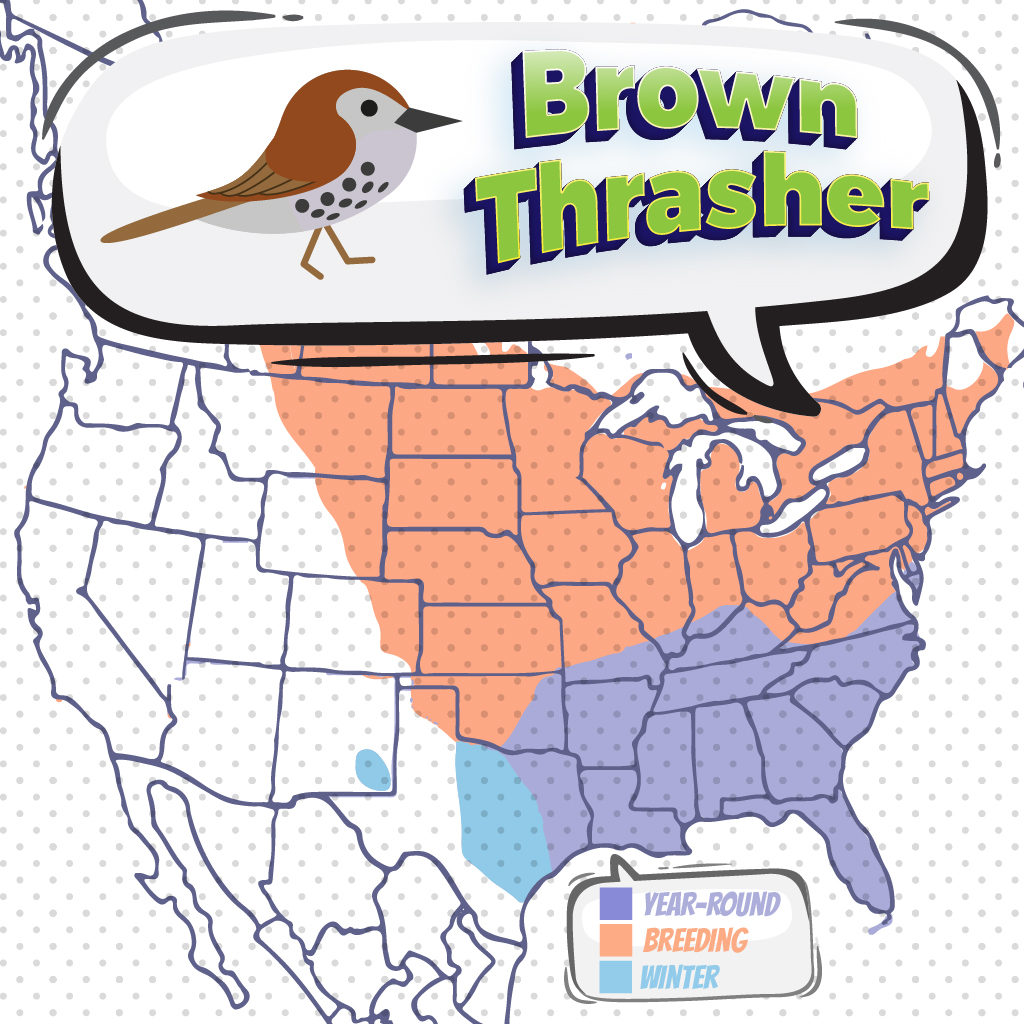
Brown Thrashers are commonly found in eastern and central United States and southern and central Canada. As the state bird of Georgia, it is the only thrasher to be present in the Rockies and central Texas. They are partial migrants, as their southern populations are permanent residents of their areas. Owing to fire suppression and tree plantation, we have observed an extension of their range west of the Great Plains. Brown Trashers that live in the New England Region of the United States migrate to Georgia and north and south Carolina. Birds in the east of Mississippi spend the winter between Arkansas to Georgia, and those in Dakota and Canada relocate to eastern Texas and Louisiana. As they migrate, they typically travel short distances during the night.
Nesting
They usually nest in shrubs, small trees, and sometimes, on the ground level. Brown Thrashers are extremely territorial about the area they are nesting in and might go as far as attacking a species as large as humans to defend their territory. They are typically monogamous, but mate-switching often occurs. Nesting is initiated by the males, who are perched atop branches and sing to attract mates. The courting ritual involves an exchange of probable nesting material. After this exchange, the nest-building duties are shared and breeding occurs after the nest is completed.
Brown Thrasher Lifecycle
They lay around 4-5 eggs after which both parents incubate the eggs for 11-14 days. The hatchlings can leave the nest after 9-13 days. The lifespan of brown thrashers can be between 3-5 years in the wild.
Ornithology
Bird Watching Academy & Camp Subscription Boxes
At Bird Watching Academy & Camp we help kids, youth, and adults get excited and involved in bird watching. We have several monthly subscription boxes that you can subscribe to. Our monthly subscription boxes help kids, youth, and adults learn about birds, bird watching, and bird conservation.
Bird Watching Binoculars for Identifying Brown Thrashers
The most common types of bird watching binoculars for viewing Brown Thrashers are 8×21 binoculars and 10×42 binoculars. Bird Watching Academy & Camp sells really nice 8×21 binoculars and 10×42 binoculars. You can view and purchase them here.
Brown Thrasher T-shirts
If you love the Brown Thrasher you should purchase a Bird Watching Academy & Camp T-shirt. To help support bird conservation we donate 10 percent to bird conservation activities.
Brown Thrasher Iron On Patches
Kids, Youth, and Adults love to collect our Bird Watching Academy & Camp iron on patches. Our bird watching patches help you keep track of the birds you have seen an identified. You can also display the patches on our Bird Watching Academy & Camp banners.
The Brown Thrasher is a great iron on patch to start your collection with. The patches are durable and can be sewn on or ironed on to just about anything.
Brown Thrasher Stickers
Stickers are a great way for you to display your love for bird watching and the Brown Thrasher. We sell a monthly subscription sticker pack. The sticker packs have 12 bird stickers. These sticker packs will help your kids learn new birds every month.
Bird Feeders For Brown Thrasher
There are many types of bird feeders. Here are our favorite bird feeders for your backyard. We use all of these bird feeders currently. Kids will have a great time watching birds eat at these bird feeders. Using this collection of bird feeders will provide a wide variety and many types of birds.
Best Bird Houses for Brown Thrasher
There are many types of bird houses. Building a bird house is always fun but can be frustrating. These 4 bird houses have become our favorites. Getting a bird house for kids to watch birds grow is always fun. We spent a little extra money on these bird houses but they have been worth the higher price and look great.


